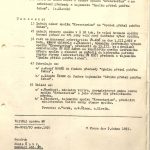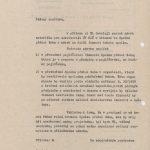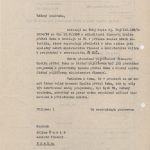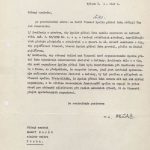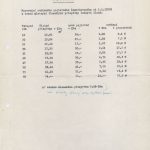The Friends of Cremation Association
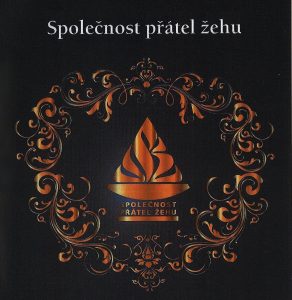
For many of us, the month of October is marked with the preparation for All Soul’s Day, held on 2 November. Without trying to invoke the bleak atmosphere, we would like to draw your attention to archival materials relating to an unusual topic, i.e., cremation, that can be found in two archival collections of the Secretary of the Federal Ministry of the Interior, namely A 2/2 inv. no. 817 (1955) and A 2/1 inv. no. 1288 (1958–1959).
On 28 October 1918, the first two burials by cremation were done in the newly built crematorium in Liberec, North Bohemia. Burial by cremation was a revolutionary act at that time, a progressive one, and also illegal: although the crematorium obtained a municipal permit in 1912, cremations were only allowed by the Austro-Hungarian law in 1918.
The new form of burial faced opposition especially from the Catholic Church that only accepted a church burial, i.e., into the ground, and although it began to admit cremation in 1926, it was not fully recognised until the 2nd Vatican Council in 1963. The new method had to be assessed from the viewpoint of legislation, and also required popularisation. For this reason, the Society for Cremation of Corpses was established in Prague in 1899, with the municipal hygienist and high councillor Jindrich Zahor (1845–1927) as the first chairman. Over time, its agenda was acquired by the Crematorium, an Association for the Cremation of the Deceased, established ten years later, on 18 March 1909. One of the shortest Czechoslovak laws legalising cremation (Act 180/1919 of 1 April 1919 comprising only two sections) is referred to as Lex Kvapil according to Jaroslav Kvapil (1868–1950), a writer, theatre director and the association’s first chairman.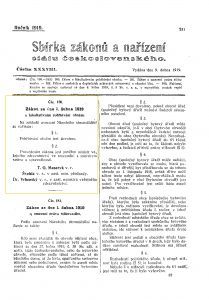 Cremations became so popular in Czechoslovakia that a cremation congress was even held in Prague in 1936. At the same time, the Crematorium association purchased a grand building in Narodni St., Prague, where it is seated even today. Despite police investigation of its leaders who were accused of fraud, new members were still coming. This was also due to the system of membership fees based on an insurance principle. The system remained functional despite the government’s repeated attempts to ban or restrict it. In 1951, the Ministry of Finance filed a proposal for a government resolution to suspend insurance activity on all associations that had carried it out in accordance with their statutes before then. The key reason was the discrepancy between their activity and the Insurance Act (Act 85/1952 Coll., Sect. 4, see also collection A 6/2 inv. no. 652 dated 1963), while the change in the association’s statues, converting it from association to “volunteer organisation” as per Act on Volunteer Organisations and Gatherings – 68/1951 Coll. was negotiated. These repeated centralist efforts were aimed at completely subjugating the association’s activities to state agencies. In spring 1955, the Central Committee of the Communist Party of Czechoslovakia discussed another proposal to transform the association and its statues. Following an approval of the Minister of the Interior, the general meeting held on 23 April 1955 approved the change of the association’s name to the Friends of Cremation Association. Its insurance licence was withdrawn in 1959 and the liabilities were passed on to the State Insurance Company which immediately raised membership fees to increase the solvency of the organisation and to avoid threatening the state budget with unexpected expenditure. The association was transformed into a “special association” as per Act 30/1939 Coll., see A 2/8 inv. no. 75 (1969–1971) and A 2/8 inv. no. 272 (1979). Its activity was further linked to state administration and the number of members gradually went down in proportion to the necessity to promote cremation. Cremation now prevails over church burials. The Friends of Cremation Society has been the successor of the Friends of Cremation Association since 1966.
Cremations became so popular in Czechoslovakia that a cremation congress was even held in Prague in 1936. At the same time, the Crematorium association purchased a grand building in Narodni St., Prague, where it is seated even today. Despite police investigation of its leaders who were accused of fraud, new members were still coming. This was also due to the system of membership fees based on an insurance principle. The system remained functional despite the government’s repeated attempts to ban or restrict it. In 1951, the Ministry of Finance filed a proposal for a government resolution to suspend insurance activity on all associations that had carried it out in accordance with their statutes before then. The key reason was the discrepancy between their activity and the Insurance Act (Act 85/1952 Coll., Sect. 4, see also collection A 6/2 inv. no. 652 dated 1963), while the change in the association’s statues, converting it from association to “volunteer organisation” as per Act on Volunteer Organisations and Gatherings – 68/1951 Coll. was negotiated. These repeated centralist efforts were aimed at completely subjugating the association’s activities to state agencies. In spring 1955, the Central Committee of the Communist Party of Czechoslovakia discussed another proposal to transform the association and its statues. Following an approval of the Minister of the Interior, the general meeting held on 23 April 1955 approved the change of the association’s name to the Friends of Cremation Association. Its insurance licence was withdrawn in 1959 and the liabilities were passed on to the State Insurance Company which immediately raised membership fees to increase the solvency of the organisation and to avoid threatening the state budget with unexpected expenditure. The association was transformed into a “special association” as per Act 30/1939 Coll., see A 2/8 inv. no. 75 (1969–1971) and A 2/8 inv. no. 272 (1979). Its activity was further linked to state administration and the number of members gradually went down in proportion to the necessity to promote cremation. Cremation now prevails over church burials. The Friends of Cremation Society has been the successor of the Friends of Cremation Association since 1966.
The association published its journal, Crematorium, in 1909–1936, renamed to Cremation in 1937. Its publication was halted during World War Two. Only one issue was published before 1948, renamed to Friendship due to controversial connotation with respect to the Holocaust. The last issue was published in 1973. An anthology was published by the Society in 1973 to remember one hundred years of the Czech cremation movement. The Society had some 16 thousand members as of 2021.


